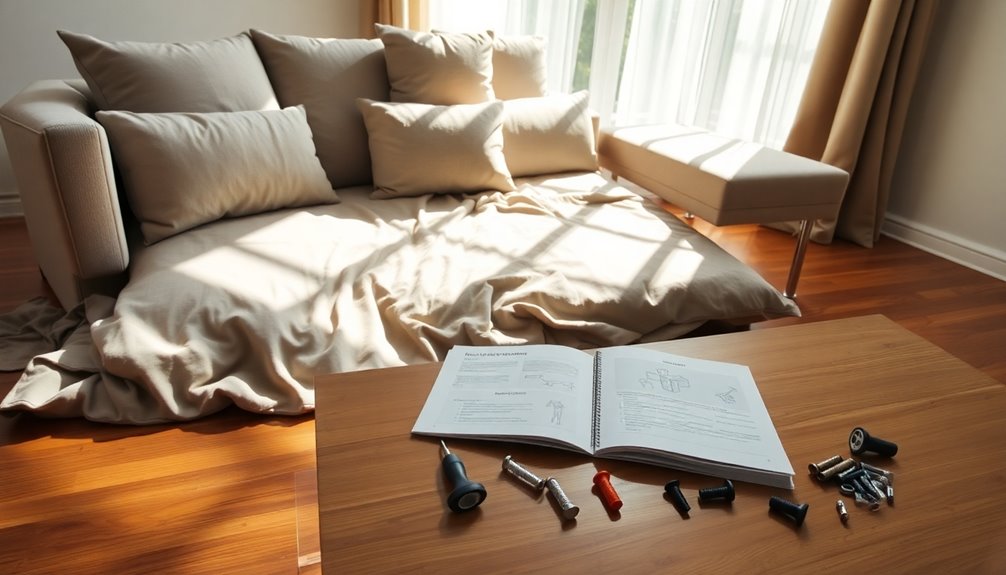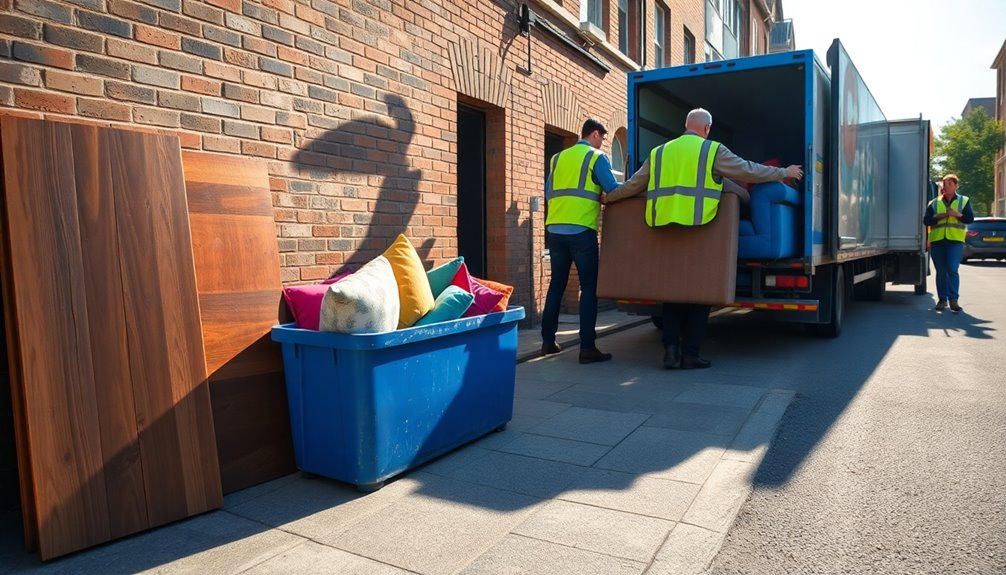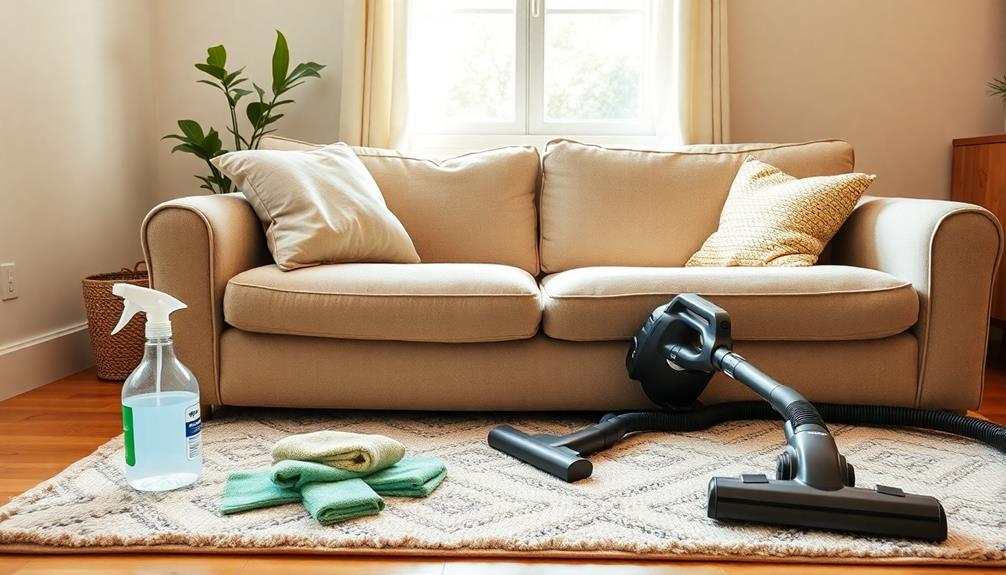Assembling a sofa is straightforward if you follow the instructions closely. Start by unpacking all the pieces and laying them out. Ensure you have the necessary tools, like a screwdriver and wrench. Attach the frame components first, securing them tightly to create a stable base. Next, position the arms and backrest, making sure they fit snugly. Once that’s done, place the cushions in position and fluff them to maintain their shape. Don’t forget to inspect for any loose screws afterward. If you stick around, you’ll discover tips for maintaining your sofa’s condition and aesthetic appeal. To enhance your living space, consider exploring various styling options after your sofa is assembled. Arranging sofa and loveseat ideas can help you maximize comfort and functionality while also allowing you to express your personal style. Experiment with different layouts and decorative pillows to create an inviting atmosphere that complements your home’s decor.
Key Takeaways
- Start by organizing all components and tools included in the sofa assembly kit to ensure nothing is missing.
- Follow the manufacturer's instructions step-by-step, ensuring you understand each phase before proceeding.
- Assemble the frame first, connecting side panels and the backrest securely using screws and brackets as specified.
- Attach the cushions according to the design, ensuring they fit snugly and align with the frame for support.
- Finish by inspecting the sofa for stability and comfort, making any necessary adjustments to ensure proper alignment.
Introduction
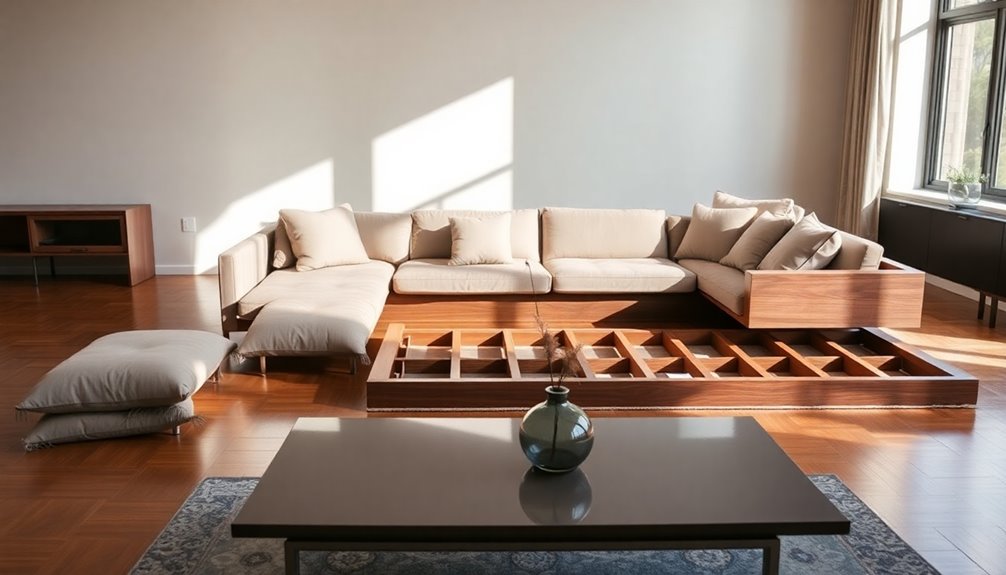
When you've put your sofa together, maintaining its look is key. You'll want to get into a routine of dusting and vacuuming, and using the right cleaning techniques for the fabric. Plus, knowing how to tackle common stains like wine and coffee can keep your sofa looking brand new.
Routine Dusting and Vacuuming
To keep your sofa looking fresh and inviting, it's essential to establish a routine for dusting and vacuuming. I'm going to help you create a simple plan. Start by dusting your sofa at least once a week to prevent the buildup of allergens and dust mites, which can affect your indoor air quality. Use a microfiber cloth or a soft duster to gently remove dust from the surface, paying close attention to seams and crevices where dust tends to accumulate.
For deeper cleaning, vacuum your sofa every two weeks using an upholstery attachment. This will effectively capture dirt and debris without damaging the fabric. Make sure to focus on high-traffic areas and cushions, as these spots collect dirt more quickly and may require more frequent attention. Additionally, using a vacuum with advanced filtration systems can help in trapping allergens and improving your indoor air quality.
If you notice any stains or spots, consider using a fabric-safe cleaner. Always test a small inconspicuous area first to ensure no discoloration occurs. By following this routine, you'll maintain your sofa's appearance and prolong its life, creating a comfortable and welcoming space in your home.
Fabric-Specific Cleaning Techniques
Your sofa's fabric type plays a crucial role in determining the best cleaning techniques to use. For cotton fabric sofas, mix mild detergent with warm water on a clean cloth. Gently blot stains, but be careful not to oversaturate, as excessive moisture can lead to water rings.
If you have a microfiber sofa, start by using a soft brush to remove dust and debris. For tougher stains, apply a small amount of rubbing alcohol to a cloth, and remember to blot, never rub, to avoid damaging the fabric.
Leather sofas require a different approach. Regularly condition the leather to keep it supple, using a specialized cleaner and conditioner every 6-12 months to prevent cracking and fading.
For synthetic fabrics, always check the care label for specific cleaning codes. Generally, a water-based cleaner is safe, but it's wise to test it in an inconspicuous area first. If your upholstery fabrics are labeled "W," use water-based cleaners; for those marked "S," stick to solvent-based options to protect the material. Following these guidelines will help keep your sofa looking its best!
Tackling Wine and Coffee Stains
Even with the best cleaning techniques, accidents can happen, and wine or coffee spills are among the most common challenges sofa owners face. When you encounter a wine stain, act quickly. Blot the area immediately with a clean cloth to absorb excess liquid, but avoid rubbing, as this can spread the stain further. For coffee stains, mix one part white vinegar with two parts water. Gently apply this solution with a cloth to lift the stain.
Before using any cleaning solution, always test it on an inconspicuous area of the fabric to ensure it won't cause discoloration or damage. If you're dealing with stubborn stains, consider using a mixture of dish soap and hydrogen peroxide. Apply it carefully and then rinse thoroughly afterward.
After treating the stains, allow the area to air dry completely. Once dry, check if the stain has been fully removed before applying any fabric protectants. By following these steps, you can effectively tackle wine and coffee stains, keeping your sofa looking its best.
Avoiding Direct Sunlight
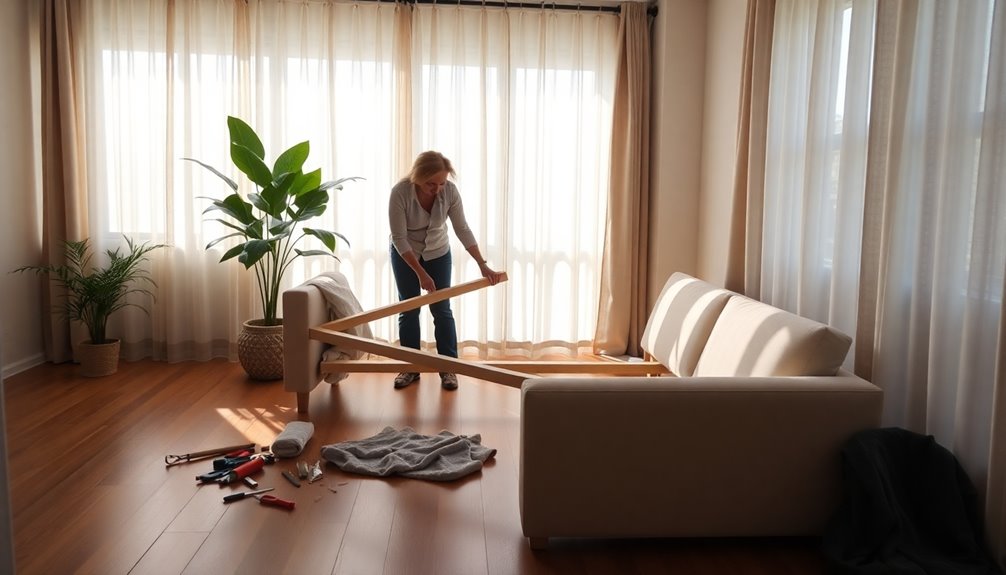
To keep your sofa looking its best, avoiding direct sunlight is essential. Consider choosing scratch-resistant fabrics and protective options to shield your upholstery from fading. Regularly rotating cushions not only helps with wear but also keeps your sofa's appearance fresh and vibrant.
Scratch-Resistant Fabric Choices
When selecting scratch-resistant fabrics for your sofa, durability and protection from sunlight are key considerations. Fabrics like microfiber and polyester blends excel in durability, making them great choices for homes with pets or heavy use. Look for upholstery with a high double rub count, ideally over 30,000, as this indicates better resistance to abrasion and scratching.
Sunlight can be detrimental; it fades and weakens fabric fibers over time. To combat this, opt for darker colors or materials that are UV-protected. These choices help maintain the fabric's integrity and appearance for longer. Additionally, regularly rotating cushions can prevent uneven wear and fading, ensuring that your sofa remains attractive.
Consider fabrics treated with protective finishes, such as Teflon or Scotchgard. These treatments can significantly enhance scratch resistance and make cleaning easier, especially in high-traffic areas. By taking these factors into account, you can choose a fabric that not only looks good but also withstands the rigors of everyday life while resisting the damaging effects of sunlight. Your sofa will thank you for it!
Decorative Fabric Protection Options
Shielding your sofa's decorative fabric from direct sunlight is essential for preserving its beauty and longevity. Start by utilizing UV-blocking window treatments, like shades or curtains, to minimize direct sunlight exposure. This simple step can significantly reduce the risk of fading and fabric damage over time.
Consider applying a fabric protector spray designed to create a barrier against UV rays, helping maintain the color and integrity of your upholstery. Additionally, think about your furniture placement; keep your sofa away from direct sunlight by using rugs or other furniture as shields.
When selecting fabrics, opt for those with inherent UV resistance, such as solution-dyed acrylic or polyester. These materials are specifically designed to withstand prolonged sun exposure better than standard fabrics. It's also beneficial to consider the tax implications of inherited IRAs when planning for future investments in home furnishings.
Lastly, it's smart to regularly rotate and rearrange cushions and throws. This practice ensures even wear and exposure to sunlight, helping maintain a uniform appearance across the sofa. By taking these protective measures, you'll keep your sofa looking vibrant and beautiful for years to come.
Regularly Rotate Cushions
Regularly rotating your cushions not only helps maintain their shape but also prevents uneven wear from frequent use in the same spots. Aim to flip and switch your cushions every few weeks. This simple practice promotes even wear, ensuring your cushions last longer and look better.
Additionally, be mindful of where you place your sofa. Avoid direct sunlight, as UV rays can fade fabric colors and weaken fibers over time. If your sofa's positioned in a sunlit area, consider using protective covers or decorative pillows to shield the cushions when not in use. This minimizes exposure and keeps your cushions looking fresh.
While you rotate your cushions, it's also a good idea to clean them according to the manufacturer's instructions. Regular cleaning prevents stains and deterioration, maintaining the overall quality of your cushions. Furthermore, understanding proper disposal habits can help in managing household waste effectively while ensuring your living space remains tidy.
Cushion Replacement Strategies

When you're replacing your sofa cushions, it's crucial to consider the integrity of the frame, as any weaknesses can affect overall support. You might also need to address leather repairs if your sofa features this material, ensuring a cohesive look. Finally, learning effective cushion fluffing techniques will help maintain their shape and comfort over time.
Frame Integrity Concerns
Maintaining your sofa's frame integrity is crucial, especially during cushion replacements. When you replace cushions, make sure they fit the existing frame dimensions. This compatibility is vital for both structural integrity and comfort. Opt for high-density foam or down-filled cushions, as these materials enhance durability and provide essential support for the frame over time.
Don't forget to regularly check the condition of the sofa frame after replacing cushions. Look for any signs of wear or damage, as neglecting this can compromise the frame's integrity. It's also wise to choose cushion covers with zippers or removable fabric. This feature makes cleaning and replacing cushions easier, ultimately prolonging the life of both the cushions and the sofa frame.
Consider your sofa's weight distribution and support needs when selecting replacement cushions. Properly supporting these areas will prevent sagging and maintain stability in the frame. By following these guidelines, you can ensure that your sofa remains not only comfortable but also structurally sound for years to come. Taking these proactive steps will keep your sofa in great shape and enhance your living space.
Leather Repair Techniques
Leather cushions add a touch of elegance to your sofa, but they can suffer from wear and tear over time. Start by assessing the damage; check for cracks, tears, or discoloration. This evaluation helps you decide on the best repair strategy. For small tears, a leather repair kit with adhesive patches can effectively seal the damage while maintaining the cushion's appearance.
If the cushion is heavily worn, consider replacing it with a new leather cover that matches the original color and texture for a seamless look. It's essential to ensure that the new cushions fit snugly in their covers, preserving the overall aesthetic of your sofa.
After completing repairs or replacements, apply a leather conditioner. This step restores flexibility and prevents future cracking or peeling, ensuring your cushions stay looking great for longer. Regular maintenance and timely repairs can significantly extend the life of your leather cushions, so keep an eye on them. By addressing issues promptly, you'll enjoy the beauty and comfort of your leather sofa for years to come.
Cushion Fluffing Techniques
After ensuring your leather cushions are in good condition, it's time to focus on keeping all your sofa cushions plush and comfortable. To maintain their shape, make it a habit to regularly fluff them by hand. Turn them over and shake them to redistribute the filling effectively. If your cushions are foam, gently knead the corners and edges to help them regain their original shape, especially after prolonged use.
For polyester fiber cushions, consider placing them in the dryer on a low heat setting for 10-15 minutes. This simple step can help restore their loftiness and comfort. Additionally, regularly vacuum your cushions using an upholstery attachment to remove dust and debris. This not only keeps them looking fresh but also prolongs their lifespan. Remember that regular inspections can help prevent issues related to pests like bed bugs that may affect your sofa's comfort.
If you find that your cushions are beyond fluffing and need replacement, ensure that the new ones match the original dimensions. This will prevent gaps or an uneven appearance on your sofa. By following these cushion fluffing techniques, you can enjoy a cozy and inviting seating area that lasts for years to come.
Custom Upholstery Fabric Choices

Choosing the right custom upholstery fabric for your sofa can significantly impact both its appearance and longevity. Start by considering durability ratings, like the Martindale rub test. A score of 30,000 or higher is ideal for heavy-use furniture. If you have kids or pets, opt for stain-resistant fabrics such as solution-dyed acrylic or polyester blends. These materials offer easy maintenance and increased longevity.
Pay attention to colorfastness and UV resistance, especially if your sofa will sit in bright sunlight. Some fabrics fade over time without proper treatment, so choose wisely. Natural fibers like cotton and linen provide breathability and comfort, while synthetic options like microfiber and nylon are known for their resilience and stain resistance.
Before making a final decision, always request fabric swatches. Evaluating the texture, color, and pattern in your home's lighting can help you choose the perfect upholstery for your style and needs. By carefully selecting your custom upholstery fabric, you'll ensure that your sofa not only looks great but also stands the test of time.
Emergency Repair Kits
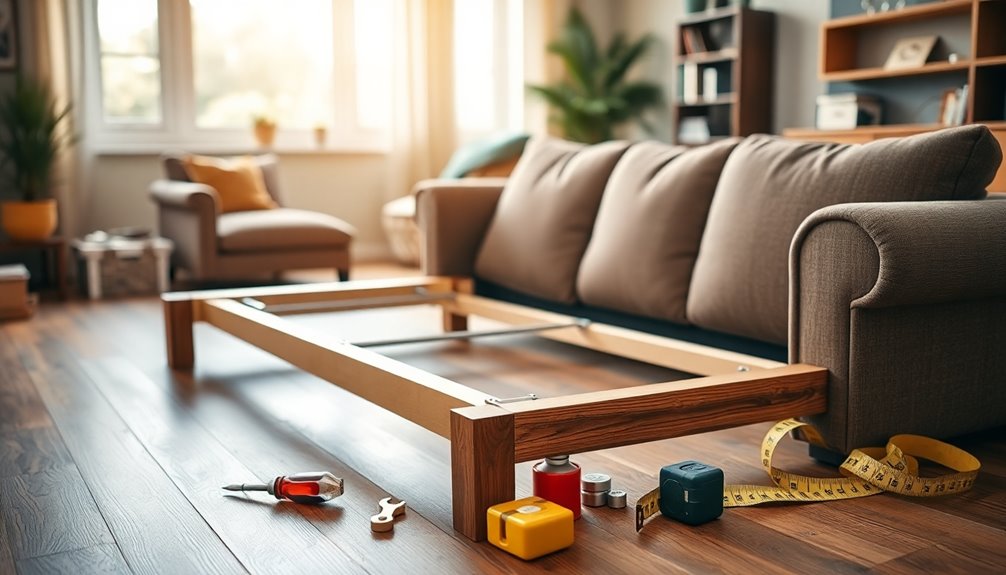
Your sofa's emergency repair kit is a vital resource for tackling unexpected issues that can arise over time. To ensure you're prepared, include essential tools like a screwdriver, wrench, and pliers for quick fixes on loose or broken components. You never know when a bolt might loosen or a screw might go missing, so having extra bolts, screws, and washers on hand can save you time and hassle.
Don't forget upholstery repair kits, which are invaluable for addressing tears, stains, or wear in your sofa's fabric. Look for kits that include fabric patches, adhesive, and seam tape to handle various upholstery issues effectively. Additionally, a small bottle of wood glue can be handy for reinforcing or reattaching wooden parts that may become loose over time.
Lastly, keep a fabric cleaner or stain remover in your emergency kit. This will allow you to quickly tackle spills or stains before they set into the fabric and become permanent. By having these tools and materials at the ready, you'll be equipped to maintain your sofa's appearance and functionality for years to come.
Conclusion
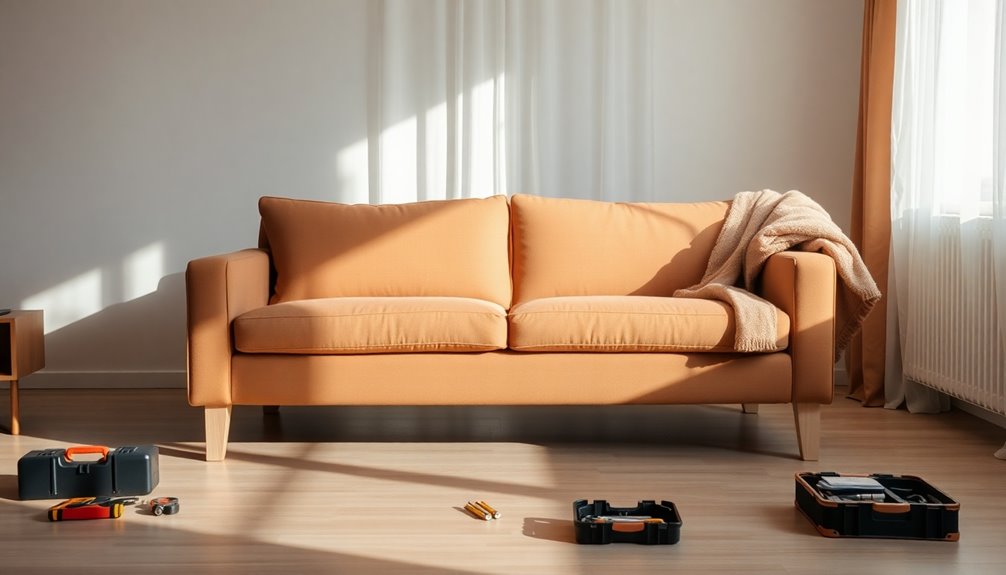
Assembling a sofa can be a rewarding experience when you follow the right steps and pay attention to detail. By thoroughly reviewing the assembly instructions, you familiarize yourself with the specific components and methods tailored to your sofa model. This preparation helps ensure a smoother assembly process.
Once you've successfully connected the sofa and chase, make sure to check that all bolts and screws are securely tightened. This step is crucial for maintaining the structural integrity and safety of your sofa. Properly aligning the brackets during connection creates a seamless and stable fit. After installation, test the stability by gently applying pressure to different areas, identifying any loose components that may need tightening.
Finally, don't forget to add cushions and decorative pillows. They not only enhance comfort but also boost your sofa's aesthetic appeal. Just ensure that all parts are securely attached before you use it. By following these steps, you can enjoy the satisfaction of a well-assembled sofa that adds style and comfort to your living space. Happy assembling!
Frequently Asked Questions
Can You Assemble a Couch by Yourself?
Yes, you can absolutely assemble a couch by yourself! It might take some patience and physical strength, especially when handling larger parts. Many assembly kits are designed for solo work, featuring lightweight components and easy-to-follow instructions. Using tools like a ratchet or power drill makes the job quicker and simpler. Just remember to check the stability and alignment of everything once you're done to ensure your couch is safe and comfortable.
How Long Does It Take to Assemble a Sofa?
It usually takes you anywhere from 30 minutes to 2 hours to assemble a sofa, depending on the design's complexity and the number of parts involved. If you've got a buddy to help, you can speed things up significantly. Sticking closely to the instructions helps, too; you might finish in as little as 20-30 minutes if the components are straightforward and pre-drilled holes are present. Just remember, practice makes perfect!
Can You Disassemble and Reassemble a Couch?
Yes, you can disassemble and reassemble a couch. Most couches come apart easily, typically using bolts and screws to secure the components. Just remember to keep track of all the hardware—like bolts and washers—so you won't lose anything during the process. If your couch has modular parts, it'll be even simpler to reconfigure. Always check the original assembly instructions for guidance, ensuring everything's tight when you put it back together for stability.
How to Attach a Sectional Sofa Together?
To attach a sectional sofa together, start by positioning the pieces close, aligning the connection points. Locate the brackets in your assembly kit and attach them to the designated spots on each section using the provided hardware. Make sure to tighten all screws and bolts securely for a stable fit. After connecting, check for alignment to ensure there are no gaps. Finally, gently shake the sectional to confirm all connections are secure before using it.
